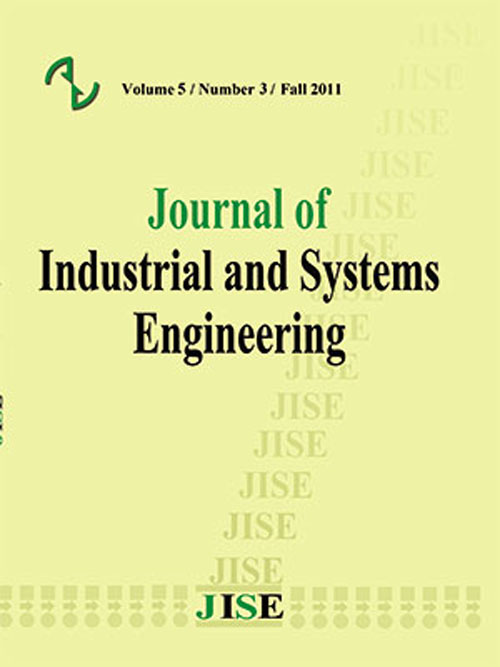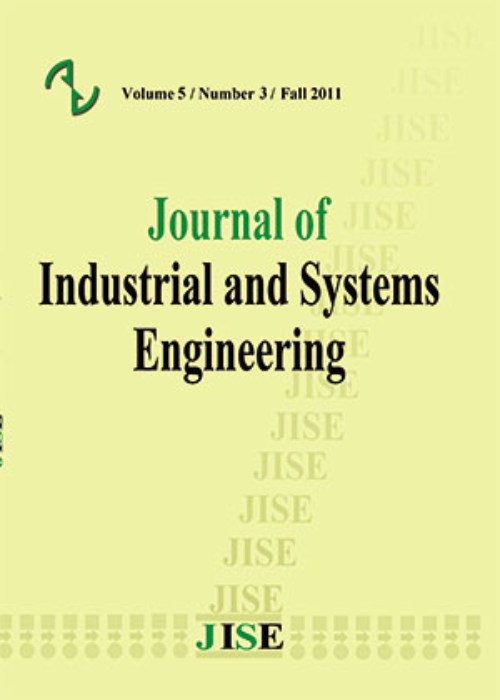فهرست مطالب

Journal of Industrial and Systems Engineering
Volume:10 Issue: 1, Winter 2017
- special issue on Quality Control and Reliability
- تاریخ انتشار: 1396/03/05
- تعداد عناوین: 7
-
-
Pages 1-16In modeling a cold standby redundancy allocation problem (RAP) with imperfect switching mechanism, deriving a closed form version of a system reliability is too difficult. A convenient lower bound on system reliability is proposed and this approximation is widely used as a part of objective function for a system reliability maximization problem in the literature. Considering this lower bound does not necessarily lead to an optimal solution. In this study by assuming that working time of switching mechanism is exponentially distributed, exact value of system reliability is derived analytically through applying Markov process and solving a relevant set of differential-difference equations. The Runge-Kutta numerical scheme is also employed to verify the accuracy of the results. It is assumed that components time to failure follow an Erlang distribution which is appropriate for most engineering design problems by giving the possibility of modeling different increasing hazard functions. A new mathematical model is presented and its performance is evaluated through solving a well-known example in the literature. Results demonstrate that a higher level of system reliability is achievable through implementing the proposed model.Keywords: Cold standby, Redundancy allocation problem, System reliability, Markov process, Differential-difference equations
-
Pages 17-33Nowadays, flexible manufacturing systems play an effective role in a variety of production and timely response to the needs of their customers. Flexible manufacturing cell is a part of this system that includes machines with flexibility in manufacturing different parts. For many years, minimizing the number of tool switches in the machines has been studied by the researchers. Most research in this field has not considered the limitations related to life and failure of the tool. Therefore, it is necessary to provide a model that, because of restrictions on tool life, the number of tool switches for a flexible cell is minimized. In this study, the impact of the tools reliability on minimizing the number of tool switches is examined. First, a mathematical model is presented for the problem. Because of the complexity of the problem, the exact solution of the problem in medium or large sizes is not possible in a reasonable time. Therefore, genetic meta-heuristic algorithm has been used for solving the problem and Keep tools needed soonest (KTNS) policy has been used to determine the optimal arrangement of tools. Then, some examples of such problem have been solved to evaluate the performance of the presented algorithm.Keywords: tool switches, Reliability, Flexible manufacturing Systems, Genetic Algorithm
-
Pages 34-58This paper proposes a multi-objective model for the economic-statistical design of the variable sample size and sampling interval multivariate exponentially weighted moving average control chart by using double warning lines. The Markov chain approach is used to obtain the statistical properties. We extend the Lorenzen and Vance cost function considering multiple assignable causes and multivariate Taguchi loss approach to obtain the expected cost per time unit. The meta-heuristic non-dominated sorting genetic algorithm is used to search for the Pareto optimal solutions. A numerical example is provided to illustrate the solution procedure. Finally, sensitivity analyses for some parameters are given.Keywords: Multivariate exponentially weighted moving average control chart, variable sample size sampling interval, double warning lines, multi-objective economic-statistical design, Non-dominated sorting genetic algorithm
-
Pages 59-77In this paper, a hybrid meta-heuristic approach is proposed to optimize the mathematical model of a system with mixed repairable and non-repairable components. In this system, repairable and non-repairable components are connected in series. Redundant components and preventive maintenance strategies are applied for non-repairable and repairable components, respectively. The problem is formulated as a bi-objective mathematical programming model aiming to reach a tradeoff between system reliability and cost. By hybridizing a standard multi-objective fire fly (MOFA) and differential evolution (DE) algorithms, a powerful and efficient approach called MOF-DE algorithm which has inherited the advantages of the two algorithms is introduced to solve this problem. In order to achieve the best performance of MOF-DE, response surface methodology (RSM) is used to set proper values for the algorithm parameters. To evaluate the performance of the proposed algorithm, various numerical examples are tested and results are compared with methods like NSGA-II, MOPSO and standard MOFA. From the experiments, it is concluded that the performance of the MOF-DE algorithm is better than other methods at finding promising solutions. Finally, sensitivity analysis is carried out to investigate behavior of the proposed algorithm.Keywords: Meta-heuristics, Reliability, Firefly algorithm(FA), Differential evolution (DE), multi-objective optimization, Preventive Maintenance
-
Pages 78-92In high quality industrial processes, the control chart is design based on cumulative count of conforming (CCC) items is very useful. In this paper, the performance of CCC-r chart with variable sampling intervals (CCC-rVSI chart) in the presence ofinspectionerrors isinvestigated. The efficiency of CCC-rVSI chart is compared with CCC-r chart with fixed sampling interval (CCC-rFSI chart). The comparison results show thatthe VSI scheme can performs better than the FSI scheme. In addition, analysis and discussion of the results are presented to illustrate the effect of input parameters on the performance of CCC-rVSI chart.Keywords: high quality processes, CCC-r chart, variable sampling interval, inspections errors, average time to signal
-
Pages 93-108The application of control charts for monitoring financial processes has received a greater focus after recent global crisis. The Generelized AutoRegressive Conditional Heteroskedasticity (GARCH) time series model is widely applied for modelling financial processes. Therefore, traditional Shewhart control chart is developed to monitor GARCH processes. There are some difficulties in financial surveillance especially in the retrospective phase one of which being the posibility of existing outliers in the samples data. For this aim, in this paper some methods were proposed to estimate the parameters of the GARCH model based on maximum likelihood and robust estimation procedures. Then, the performance of Phase II residual Shewhart control chart with estimated parameters was evaluated according to in-control Average Run Length in the presence of outliers. The Monte Carlo simulation study was applied to evaluate the proposed methods considering different numerical examples. Finally, the US Dollar/Iran Rial (USD/IRR) exchange rate was considered for monitoring in which the results showed that the control chart was more sensitive when the robust methods were applied in the estimation procedure.Keywords: Financial surveillance, retrospective phase, GARCH model, robust estimation, foreign exchange rate
-
Pages 109-124In today's competitive market, all manufacturers attempt to improve their maintenance policy in order to decrease the cost of failure and increase the quality of products, but most of these attempts do not consider the role of humans involved in a manufacturing system. Human resources are the main factor in manufacturing that has an undeniable effect on products quality, machines reliability, safety and maintenance policy. In this paper we propose a nonlinear mathematical model that optimizes the maintenance policy considering the humans fatigue to investigate its effects on reliability and associated Costs in manufacturing system.
That is to say, the model is a reliability based maintenance optimization that aims to maintain the reliability of machines and their human resources in a proper predetermined interval. The performance of the proposed model was examined by some instances and the obtained results indicated this model can provide effectiveness maintenance policy for manufacturing systems.Keywords: Maintenance, human resource, fatigue, Optimization, Reliability, Production, scheduling


